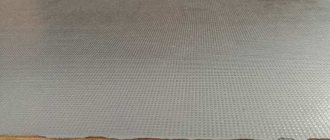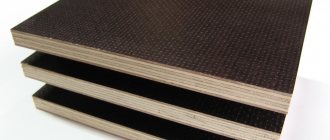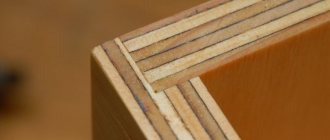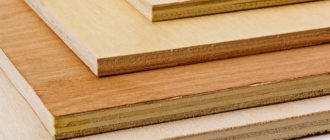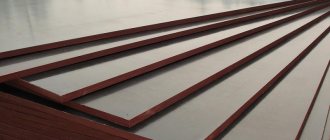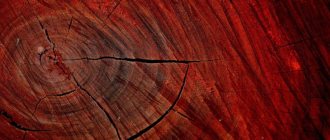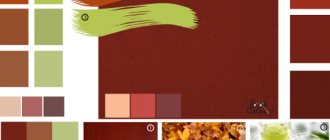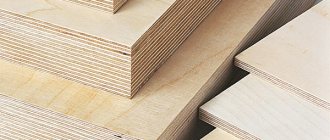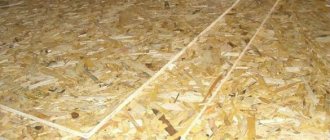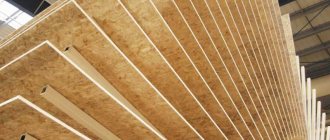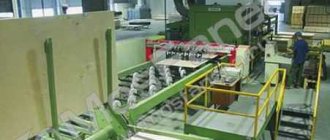The popularity of plywood products has grown even more after the development of the technology of applying laminated films. Protective coatings allow the material to be used in conditions that conventional sheets of glued veneer cannot withstand.
Waterproof laminated plywood can withstand both heavy mechanical loads and exposure to aggressive humid environments. It has found application in the production of furniture, decorative finishing of premises and transport, and the manufacture of electrical equipment.
Raw materials for plywood
The basis for lamination is plywood made using standard technologies from wood raw materials. Most often, birch and coniferous veneer are used, from which a homogeneous or combined material is made. When different raw materials are combined, the inner layers of a multilayer product are made from one wood, and the outer layers are made from raw materials of other species.
According to tradition, veneer grades are designated by the letters: A, B, C, where A is the best quality and C is the lowest quality. For outer layers, veneers A, AB, B, BB are most often used. According to the updated standard, the designations of which are not always used, the quality of the best veneer raw materials is designated by the letter E, the rest (in descending order) by numbers from 1 to 4. The marking of veneer from coniferous trees contains the letter X.
Note! Humidity indicators are of great importance for ensuring the strength of plywood products, which should be 8% with permissible deviations in both directions of 2%.
Low-grade veneer is not used for the production of laminated plywood, because the process is not economically justified. It makes no sense to put effort into laminating products intended for rough work.
Glue is applied to wood chips with rollers until the raw material is completely saturated. How much adhesive is needed depends on the density, structure and nature of the veneer.
The veneer layers, lubricated with adhesives, are first subjected to light cold pressing, then final fixation is ensured by mechanical compression under conditions of high pressure and temperatures reaching 130 ℃.
The semi-finished product for the production of laminated plywood is subjected to mandatory grinding in order to remove irregularities. The permissible thickness difference ranges from 1/8 to 1/5 of the total thickness of the resulting sheet.
Laminated plywood and its areas of application
Laminated plywood is a universal finishing material used in various areas of production, be it construction or finishing. Covered on both sides with a special paper-resin film, such plywood has a considerable service life and is protected from moisture. These properties make plywood a very popular material.
The use of plywood in monolithic frame construction
In monolithic frame construction, plywood is used for the manufacture of formwork, as well as cladding of various surfaces in the construction of warehouses, fences, bridges, supports and much more.
For formwork, plywood is good because its surface can withstand more than two hundred cycles of working with concrete; for facing work, its moisture resistance and appearance are optimal.
To maximize the number of uses for formwork, you need to follow certain rules for caring for plywood.
Naturally, when making formwork forms, sawing of sheets will be required to adjust the dimensions. The cut edge is not protected by the laminate, so it is the most vulnerable point of the plywood. To prevent moisture from entering through the cut, it is treated in several layers with special acrylic paint. Other holes in the surface required for mounting the mold are sealed with a silicone solution.
In order to avoid concrete sticking to the plywood, its surface must be coated with a special lubricant. At the end of the cycle, after disassembling the mold, you need to clean the plywood from adhering pieces of concrete. Coating with a lubricant, moreover, gives an almost perfectly flat and smooth concrete surface.
Having dismantled the form, the plywood sheets must be dried and laid until the next cycle, and it must be stored at the same temperature at which the work was carried out. Compliance with these rules will allow you to use the formwork as many times as possible.
Design of residential and office premises
The film coating of plywood can have a variety of shades, which makes it possible to use this material in various types of office or apartment interiors.
In addition to being resistant to moisture, it retains heat well and has soundproofing properties. Plywood is used for the manufacture of partitions of any kind, window sills, and also as a decorative material for wall panels.
For exterior decoration, it is well suited for the design of facades, and the use of plywood allows you to create very original design projects.
Furniture production and transport
The translucency of the paper-resin film gives plywood the appearance of natural wood, which makes it possible to use the material in furniture production. Laminated plywood is used to make cabinets, wardrobes, shelving and much other furniture. Almost all furnishings in public places are made of plywood.
This material is practically irreplaceable in transport. These are partitions, trim and floors of car vans, buses and trucks. In railway cars, all interior decoration is made entirely of plywood.
In water transport, plywood is also found everywhere, and the construction of boats and yachts is generally unthinkable without this material.
Rules for working with plywood
Processing of plywood can be carried out in various ways, both manually and on an electric machine.
When processing, it should be taken into account that the glue with which the plywood is impregnated has a fairly strong structure and the cutting surfaces of the tools wear out very quickly. Therefore, it will be better if the tool is made of carbide.
The highest quality sawing of plywood is carried out with a band saw or circular saw. To make the cut smooth and clean, the cut with a band saw or hand saw should be made from the front side, first across the grain, then along. With this method, the corners are not split. The reverse side is cut using a circular saw in the same way.
It is recommended to use threaded nails or screws with a hidden head for attaching wall panels, as well as attaching plywood to floors and ceilings. For hidden driving, most ordinary nails are suitable. Stainless acid-resistant nails are used for nailing cladding panels during exterior finishing.
The length of the nail should be 2.5-3 times greater than the panel thickness. On walls and ceilings, nails are driven in at a frequency of 10 to 20 centimeters along the edge of the panel, and from 20 to 30 centimeters in the middle. The frequency variation depends on the type of nail and its load.
When attaching the panel to the floor, the interval between nails increases - from 20 to 30 centimeters along the edge and from 40 to 50 in the middle. The optimal distance from the edge of the panel is 1.2-1.5 centimeters. The nail heads must be wide enough to avoid breaking the plywood; the length of the nail determines the reliability of fastening the panel.
To achieve the greatest strength of the structure, it is better to coat the joints with glue. To use screws, you need to drill holes in the plywood.
In order for the edges of the hole to be smooth when drilling, drilling must be done from the front side and the drill must have a front cutter. A lining should be placed under the sheet, then there will be no splitting.
The holes for the screws must be of the appropriate diameter, the head of the screw must remain outside and not be recessed into the panel. When using domed nails, washers are used.
If plywood is attached to metal structural members, it is best to use screws to fasten it from the back side while leaving the front side intact. Plywood is attached to the floor of car trailers, as well as containers, with self-tapping screws.
Another option for fastening a plywood panel is bolting, and the diameter of the hole for the bolt should exceed the diameter of the bolt itself by 0.2 centimeters. Washers are placed under the caps and nuts.
To avoid crushing the plywood, tighten the bolt carefully and do not overtighten the bolt. Tightening the bolt too tightly leads to the head being pressed in, and subsequently cracks form around the head.
Fittings, locks, as well as shelves are securely fastened anywhere on the plywood sheet; the most reliable fastening is carried out using clamping devices. Holes must be drilled for the screws.
Installation, gluing and sanding of plywood panels
Installation of plywood on structural elements is carried out in various ways, using screws and bolts, nails, rivets, staples, and glue. When determining the fastening method, you need to take into account the compatibility of the appearance of the fasteners with other design elements and the required structural strength.
If heating is expected, ventilation of the plywood must be ensured. A small gap of 0.2 centimeters should be left in the joints between the sheets of plywood. It is necessary in case of possible swelling or expansion of the material.
In plywood structures, connection methods and the correct location of joints are of great importance. The strength and stability of the structure depends on this. Plywood boards are connected with tenons, tongues and other methods.
The ends of the sheets, which have a cut, are the most vulnerable point of the slab, since they are least protected from external influences. The ends of slabs used for external finishing must be additionally processed; the most effective protection is provided by joining with strips. Aluminum profiles best protect the cut of plywood boards. To connect panels under the roof and slabs fixed to the floor, the tongue-and-groove method is used. This connection avoids damage to the roof and securely holds the plywood boards on the floor.
When gluing bare plywood, wood glue is traditionally used. PVA is absolutely colorless and is most suitable for interior decoration; the use of phenol and epoxy glue is best suited for exterior decoration and gluing to metal.
Laminated plywood is not very suitable for gluing. Under load, the film may separate from the plywood and the structure or fastening will be damaged. If it is still necessary to glue the laminated board, the surface should be thoroughly cleaned until the film is completely removed. Since the value of such a board lies in its processing and film coating, its use for gluing is inappropriate. The glue is applied in a thin layer to both surfaces intended for gluing. To ensure that the glue spreads evenly, it is better to apply it with a brush or roller. Before the gluing process, you should carefully study the instructions for using the glue.
Sanding the plywood panel is carried out with coarse sandpaper across the grain. To achieve a completely smooth surface for varnishing, you need to sand along the grain with fine-grained sandpaper.
The smooth, perfectly sanded surface of the plywood board provides the optimal basis for any finish. In addition to lamination, it can be impregnated with the necessary solution or painted. The possibility of subsequent cracking during priming or painting should be taken into account, so the appropriate paint must be selected. The surface of the plywood can be covered with wallpaper, film or covered with veneer made from valuable wood species.
Finishing and processing of plywood
When stored in a room with a high level of humidity, plywood should be dried before finishing and cleaned of dust and waste generated during processing. After sawing, the cut of the plywood board can be processed with a knife or plane to remove the resulting chips. The processing direction is from the corners to the middle, thereby maintaining the integrity of the corners. To achieve the best result, the cut can be sanded and then treated with acrylic-based paint.
Wood is a natural material that changes its physical parameters under the influence of the environment. As the humidity level increases, plywood swells, changing thickness and other parameters; heating also causes an increase in volume. Dry and cool air causes the opposite process. These changes can cause cracks in the veneer.
To avoid their occurrence, the surface should be pre-primed before painting. The surface must be painted with special elastic paints. When using plywood boards for exterior finishing, it is necessary to paint not only the front side, but also the back side. The ends and cuts of the slab must be repeatedly processed with special care.
Thanks to its special texture, after painting with a special paint, plywood takes on the appearance of colored wood fiber; its surface can also be painted so that the texture is not visible. It is better to apply paint with a brush, roller or spray. The use of plywood boards of various colors is acceptable for finishing indoors and outdoors.
It is recommended to pre-treat plywood surfaces with a special solution that prevents the appearance of wood fungus and discoloration.
Plywood made from birch can be varnished. Before applying varnish, the surface of the plywood panel must be thoroughly sanded with fine abrasive paper, and any dust that appears during the sanding process must be removed. The varnished plywood panel has a pleasant aesthetic appearance and does not require special care.
When used correctly, plywood can create any interior. Since plywood panels are great for both exterior and interior decoration, it is easy to add variety to your living space. Compliance with certain rules of use, as well as correct application and processing, significantly increases the service life of this convenient material. The presence of certain qualities makes laminated plywood an indispensable material for everyday life and in manufacturing industries.
Application of laminate
To obtain a laminated surface, thin protective films are placed on the plywood, which are pressed at a temperature of 136 ℃.
The time for applying the protective layer of the laminate depends on the thickness of the plywood layer and the type of polymer agent. To obtain coatings the following is used:
- melamine compounds;
- phenol-formaldehyde macromolecules;
- vinyl chloride polymers.
The process is carried out quickly. The maximum amount of time required for recording is 10 minutes. After heating, the thermosetting coating hardens completely and irreversibly.
On some types of plywood, the protective function is performed by paper oiled or impregnated with resins and secured using presses.
After receiving the laminated surface, they begin to process the ends, which must be done to ensure the durability of the plywood. They are usually coated with acrylic compounds.
Laminating film type
Plywood is most often laminated using phenolic, polyvinyl chloride and melamine films. All these films are kraft paper impregnated with resin.
— Melamine film is transparent or light yellow due to the lack of coloring pigments, and is rarely used in modern house construction.
— Phenol-formaldehyde film is dark brown in color. The coating is dense and moisture resistant. Due to its special strength, such sheets can be used for industrial and outdoor work, for the manufacture of formwork and repeated pouring of concrete.
— PVC film is a thin plastic that is applied to plywood using a thermal method. This is the most expensive and rarely used coating.
Varieties and main varieties
According to the state standard approved in 2010, laminated plywood is designated by the abbreviation FOB and is made from birch veneer. Laminated plywood products from other types of veneer raw materials are produced according to the technical specifications of manufacturing enterprises. In relation to them, the marking FOF is sometimes found.
Depending on the resulting surface texture on one or both sides, products are marked with the following letter combinations:
- F/F – smooth film surface on each of two sides;
- F/W – film on one side and mesh on the other side;
- SP/SP – smooth double-sided film coating, prepared for subsequent painting;
- F/SP is a film that is not painted on one side of the plywood, but pigments are applied on the other;
- F/U – one side is smooth, the other is untreated.
According to GOST, finished laminated products are divided into grades: from 1st to 3rd. Products of the first grade cannot have areas not protected by polymers; the permissible overlap of the laminate should not exceed 5 mm.
Adhesion of pieces of remaining polymer may occur in areas of up to 5 cm2. There should be no scratches or damage on products of this class.
Laminated products of the 2nd grade can have up to 3 blisters, 2 scratches, spots, the size of which does not exceed 10% of the area.
The number of defects on grade 3 laminated plywood is not strictly limited; It has the most affordable price; when used, it requires additional effort to mask flaws.
Material advantages and disadvantages
Sveza laminated plywood has the following advantages:
- Resistance to adverse environmental influences. The surface of the described material is resistant not only to abrasion, but also to the effects of various chemicals.
- The coating does not swell during operation. That is why during installation it is not necessary to leave gaps between the walls and the material if it is used as a floor covering.
- Long service life. With proper care, the material can be used for several decades. It should be taken into account that the period of use depends on the degree of load on the surface.
- Beautiful surface. It is worth noting that laminated plywood can be easily cleaned of various contaminants. At the same time, it can be washed with water, as it is resistant to moisture.
- The described products can be easily repainted in the color you need.
If you want to make the design of the room non-standard, colored laminated plywood is used. When choosing a shade, it is important to consider that the product must be combined with the decoration of the rooms.
In addition to the advantages, the described products also have disadvantages, which include:
- high production costs, which is reflected in the cost;
- When burned, the resins used to produce the protective coating release toxins.
But it is worth noting that in the event of a fire, the release of toxins will be the least of the problems. Most often, laminated plywood 18 mm 1220x2440 is used to create floors.
Formwork and transport products
All types of plywood for which resins were used are highly resistant to moisture: bakelite, formaldehyde or melamine. Only products made from veneer glued with protein agents are not suitable for use in a humid environment.
Laminated plywood for formwork based on FSF sheets has an increased degree of protection, has a polymer coating on the outside that repels water, and is characterized by high turnover. This means that the formwork material can be used up to 50 times, and with careful care and careful use - up to 100 times. With such a turnover, the cost of purchasing high-quality laminated plywood will pay for itself many times over.
To increase the resistance of the outer surface to abrasion and reduce slipping, polymer meshes with different cell sizes are fixed on the sheets. Such mesh plywood is also called transport plywood, since it is used for lining the bottom of vans and ships.
Laminated transport plywood has a corrugated surface, helps keep cargo in its original installation location, and simplifies the loading and unloading procedure. It can also be used for formwork, trailer cladding, garden furniture, and playgrounds.
Characteristics
Laminated plywood is usually made on the basis of FSF brand boards. For gluing veneer sheets, water-insoluble phenol-formaldehyde resins are used. As a result, the material has the following characteristics:
| Characteristics | Options |
| Density | Within 640-700 kg/m3 |
| Emission class | E1 |
| Humidity | No more than 10 percent |
| Ultimate tensile strength | 40 MPa |
| Bending strength | 60 MPa |
From this we can conclude that this material is durable. Together with high moisture resistance, this makes wood plywood sheets very durable.
Colored coatings
Pigments can be added to the synthetic layer to give a particular color to the material.
White laminated plywood can be used to decorate the bathroom and other wet rooms in the apartment. At the request of customers, many enterprises are ready to make products in different colors. Modern technologies make it possible to quickly apply dyes to laminated wood products.
Bright colored sheets are used for the construction of children's playgrounds.
Darker or lighter laminated plywood is used for the production of vans, seats in public places, and partitions in transport.
